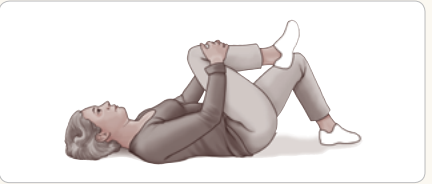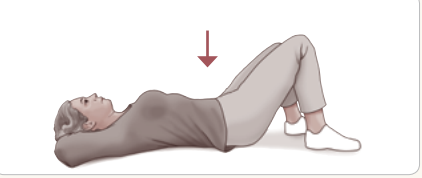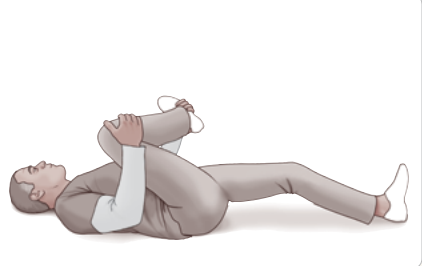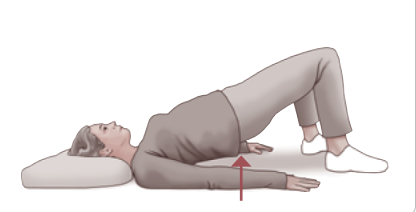Stretching and strengthening exercises to relieve and prevent lower back pain
- Reviewed by Robert H. Shmerling, MD, Senior Faculty Editor, Harvard Health Publishing; Editorial Advisory Board Member, Harvard Health Publishing

Lower back pain is a common medical problem, affecting millions of people worldwide. Stretching and strengthening exercises may help prevent episodes of low back pain. Exercising while experiencing low back pain can also help, but requires a slow and cautious approach.
Stretching and strengthening exercises to prevent lower back pain
One of the best things you can do to prevent low back pain is to strengthen your back. Stronger and more flexible muscles are less likely to get injured.
Back muscle training may help protect you from injury and back pain. It's also important to stretch and strengthen core muscles, which help to support the spine. Therefore, a stretching and strengthening regimen should target the back, abdominal, buttock, and upper leg muscles.
Muscle-strengthening and stretching exercises such as the ones below can be very helpful. Try to do these exercises at least twice a week.
Knee to chest stretch

- Lie on your back with both knees bent.
- Pull one knee toward your chest and hold it for 5 to 10 seconds.
- Return to the starting position.
- Repeat with the other leg.
- Do this 5 to 10 times with each leg.
Pelvic tilts

- Lie on your back with both knees bent and your feet on the floor.
- Gently flatten your lower back to the floor and hold for 5 to 10 seconds, then relax.
- Do this 5 to 10 times.
Knee cradle

- Lie on your back with your legs straight out.
- Bend your right knee and rotate your hip so that the lower leg is across your chest, pointing to the left. You should feel this stretch in your thigh.
- Hold for 5 to 10 seconds, then return to the starting position.
- Do this 5 times with each leg.
Bridge

- Lie on your back with both knees bent and your feet on the floor.
- Gently raise your buttocks off the floor 4 to 6 inches, hold for 5 seconds.
- Return to the starting position.
- Do this 5 to 10 times.
Stretching and strengthening exercises to relieve lower back pain
It may be a good idea to consult with your doctor before starting any exercise if you are experiencing back pain. Depending on the cause of your pain, certain exercises might make it worse. For example, if you have sciatica, certain stretches or movement may aggravate your pain and condition.
Otherwise, you may be able to gradually start gentle daily exercises to stretch and strengthen the muscles supporting your lower back once you are no longer in severe pain. In addition, try to get up regularly and walk around to the extent you can.
Low back pain caused by muscle strain or spasm can often be improved with exercises such as those described above. Research has found that certain exercises like tai chi, yoga, Pilates, and core or stabilization exercises can significantly help people with chronic low back pain. With any exercise, keep in mind that pushing muscles and joints too far too fast can lead to injury, so take a gradual and cautious approach.
Moderate cold or heat, along with over-the-counter pain relievers, can also help to ease discomfort.
How to prevent low back pain
Preventing back pain is easier than treating it. Fortunately, there are many things you can do to prevent this type of pain:
- Lift properly. Use your legs, not your back, when lifting objects. Bend at your knees and keep your back straight. Stand close to the object and hold the object close to your body. Tighten your stomach muscles and lift with your leg muscles.
- Maintain good posture. Avoid slouching when standing or sitting. Sit up straight with your back against the chair and feet flat on the floor. Stand tall with your head up and shoulders back. Take regular breaks from sitting: If you work at a desk, take regular breaks to move around.
- Maintain a healthy weight. Achieving and maintaining a healthy weight reduces the strain on your back.
- Stay active. Regular physical activity keeps your back muscles strong. Aim for at least 150 minutes of moderate-intensity aerobic activity each week.
- Get enough calcium and vitamin D. These nutrients keep your bones strong and help to prevent osteoporosis, which can cause back pain if it affects the spine.
- Quit smoking. Research shows that smokers have more frequent episodes of back pain than nonsmokers, and the more people smoke, the higher the risk.
Understanding lower back pain: Why does it hurt?
Your lower back, which consists of the five vertebrae in the lower part of your spine between the lower ribs and pelvis, supports your body. The vertebrae are cushioned by spinal discs, which act as shock absorbers for the spine. Nerves, ligaments, and muscles in the lower back are also important for your body's movement and control.
Because your lower back supports the weight of your body, many problems can arise in this area. Whether it flares up after a fall, or after a movement as subtle as lifting a laundry basket, low back pain can be debilitating.
There are two types of low back pain. Acute low back pain is a sudden, sharp pain and usually short-term. Chronic low back pain is a dull, constant ache and lasts longer. Chronic low back pain is a leading cause of disability worldwide.
In addition to pain, lower back discomfort may be characterized by:
- tightness
- stiffness
- muscle spasms
- radiating pain
- tingling/numbness.
What causes lower back pain?
Although many episodes of back pain can be traced back to a specific event, such as a fall or straining a muscle at the gym, that's not always the case. For example, nonspecific back pain results from muscle strain due to activities like lifting or bending, but is not linked to a specific injury.
Many medical conditions, several of which can take years to develop, can also lead to low back pain.
Degenerative disc disease refers to a condition in which spinal discs become damaged and cause discomfort. The damage may include cracks, tears, or loss of fluid.
Bulging and herniated discs occur when wear and tear has progressed to a point where the discs bulge, or herniate, potentially pressing on nerves and causing leg pain (sciatica).
Osteoarthritis can affect the spine's facet joints, which connect the bones of the spine, leading to painful joint degeneration, inflammation, and bony growths (bone spurs).
Spondylolisthesis is a condition in which one or more bones in the lower spine slips forward, causing severe low back pain as well as discomfort in the hips and thighs.
Lumbar spinal stenosis is a narrowing of the spinal canal. This can cause nerve compression, resulting in pain.
Ankylosing spondylitis is a form of arthritis in which inflamed spinal joints can become fused so they are no longer able to move independently. The condition can cause pain and stiffness.
Serious spinal conditions such as spinal infection, tumors, and cauda equina syndrome are rare.
About the Author

Jenette Restivo, Health Writer; Assistant Director for Digital Content Creation and Engagement, Harvard Health Publishing
About the Reviewer

Robert H. Shmerling, MD, Senior Faculty Editor, Harvard Health Publishing; Editorial Advisory Board Member, Harvard Health Publishing
Disclaimer:
As a service to our readers, Harvard Health Publishing provides access to our library of archived content. Please note the date of last review or update on all articles.
No content on this site, regardless of date, should ever be used as a substitute for direct medical advice from your doctor or other qualified clinician.















